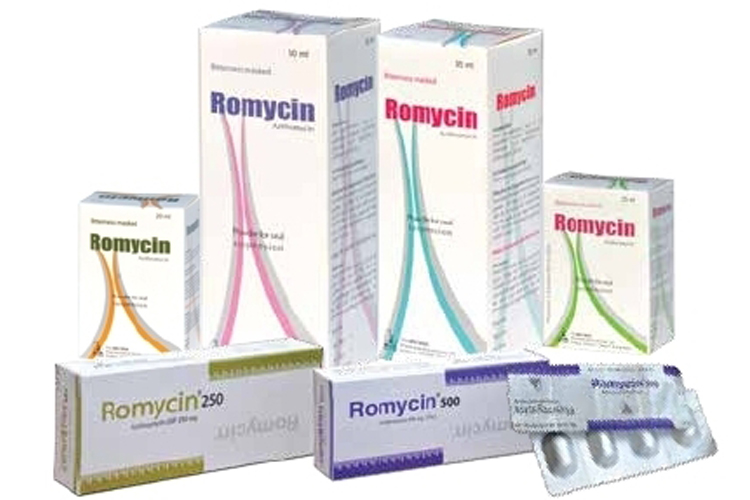
ROMYCIN
AZITHROMYCIN DIHYDRATE USP
| NAME | STRENGTH | PACK SIZE | DOSAGE FORM |
|---|---|---|---|
| ROMYCIN 200 MG/5 ML | 200 MG/5 ML | 15 ML | POS |
| ROMYCIN 200 MG/5 ML | 200 MG/5 ML | 20 ML | POS |
| ROMYCIN 200 MG/5 ML | 200 MG/5 ML | 35 ML | POS |
| ROMYCIN 200 MG/5 ML | 200 MG/5 ML | 50 ML | POS |
| ROMYCIN 250 MG | 250 MG | 8 S | CAPSULE |
| ROMYCIN 500 MG | 500 MG | 20 S | TABLET |
Romycin 250 Capsule: Each capsule contains Azithromycin 250 mg as Azithromycin Dihydrate USP. Romycin 500 Tablet: Each Tablet contains Azithromycin 500 mg as Azithromycin Dihydrate USP. Romycin 15 ml Suspension: After reconstitution, each 5 ml suspension contains Azithromycin 200 mg as Azithromycin Dihydrate USP. Romycin 20 ml Suspension: After reconstitution, each 5 ml suspension contains Azithromycin 200 mg as Azithromycin Dihydrate USP. Romycin 35 ml Suspension: After reconstitution, each 5 ml suspension contains Azithromycin 200 mg as Azithromycin Dihydrate USP. Romycin 50 ml Suspension: After reconstitution, each 5 ml suspension contains Azithromycin 200 mg as Azithromycin Dihydrate USP.
Romycin (Azithromycin) is a macrolide antibiotic. It acts by binding with the 50s ribosomal subunit of susceptible microorganisms and thus interfering with microbial protein synthesis. Azithromycin has been shown to be active against most strains of the following microorganisms and in clinical infections of Staphylococcus aureus, Streptococcus agalactiae, Streptococcus pyogenes, Streptococcus pneumoniae, Haemophilus influenzae, Moraxella catarrhalis, Chlamydia trachomatis etc. About 40% Azithromycin of an oral dose is absorbed rapidly and widely distributed throughout the body.
Romycin is indicated for the treatment of mild to moderate infections; Lower respiratory tract infection: Acute bacterial exacerbation of chronic obstructive pulmonary disease (COPD), Community acquired pneumonia of mild severity patients appropriate for outpatient oral therapy. Upper Respiratory tract Infection: Acute pharyngitis, tonsillitis. Gastrointestinal tract infection: Enteric fever or typhoid fever, infectious diarrhoea etc. Skin and skin structure Infections: Uncomplicated skin and skin structure infections. Sexually transmitted diseases: Non-gonococcal urethritis and cervicitis. Mycobacterial infections: For prophylaxis, disseminated Mycobacteruim avium complex (MAC) disease.
Romycin Capsule should be given at least 1 hour before or 2 hours after a meal and tablets can be taken with or without food. Adults- The recommended dose of Romycin for the treatment of mild to moderate acute bacterial exacerbations of chronic obstructive pulmonary disease (COPD), pneumonia of mild severity, pharyngitis, tonsillitis and uncomplicated skin and skin structure infections is 500 mg as a single dose on the first day followed by 250 mg once daily on days 2 through 5. For the treatment of Enteric fever or typhoid fever the recommended dose is 1g once daily for 5 days or 1g on day first and 500 mg for the following 6 days and for infectious diarrhoea the recommended dose is 1g once daily. The recommended dose of Azithromycin for the treatment of genital ulcer disease is 1000 mg as single dose. The recommended dose of Azithromycin for the treatment urethritis and cervicitis is a single dose of 2000 mg Azithromycin. Children -Use of Azithromycin over 6 months of age is recommended. In acute otitis media and community-acquired pneumonia the recommended dose of Romycin oral suspension is 10 mg/kg as a single dose on the first day followed by 5 mg kg/Ð1 day Ð1 on day 2-5 (not exceeding 500 mg/day). The recommended dose of Romycin for oral suspension for the treatment of children with pharyngitis/tonsillitis is 12 mg/kg once a day for 5 days (not exceeding 500 mg/day).
Azithromycin is contra-indicated in patients with known hypersensitivity to Azithromycin, erythromycin or any macrolide antibiotic.
Because Azithromycin is principally eliminated via the liver, thus caution should be exercised when Azithromycin is administered to patients with impaired hepatic functions. Pregnancy: Azithromycin should be used during pregnancy only if clearly needed. Nursing mother: Caution should be exercised when Azithromycin is administered to a nursing mother. Pediatrics' use: Safety and effectiveness of children under 6 months of age have not been established for Azithromycin.
Most reported side effects were mild to moderate severity and reversible upon discontinuation. Transient elevations of liver enzyme values and rarely cholestatic jaundice have been reported. Rash, headache, dizziness may occur, Gastrointestinal side effects are; nauses, vomiting, diarrhoea or abdominal pain.
Azithromycin should be used during pregnancy only if clearly needed. And it is not known whether Azithromycin is excreted in breast milk, so caution should be exercised when it is administered to a nursing mother.
Azithromycin should be taken at least 1 hour before or 2 hours after taking antacids. Concomitant administration of ergot derivatives and Azithromycin should be avoided. Caution should be exercised while co-administration of Digoxin and Cyclosporin is necessary.
Symptoms
The typical symptoms of an overdose with macrolide antibiotics include reversible loss of hearing, severe nausea, vomiting and diarrhoea.
Treatment
In the event of overdose the administration of medicinal charcoal and general symptomatic treatment and supportive measures are indicated as required.
Store in cool & dry place, below 250C and protect from light.
Romycin 250 Capsule: Box contains 08 (2×4's) capsule alu-alu blister pack.
Romycin 500 Tablet: Box contains 12 (3×4's) tablets in alu-alu blister pack.
Romycin Suspension 15 ml: Bottle contains dry powder for 15 ml oral suspension with a measuring cup & dropper.
Romycin Suspension 20 ml: Bottle contains dry powder for 20 ml oral suspension with a measuring cup & dropper.
Romycin Suspension 35 ml: Bottle contains dry powder for 35 ml oral suspension with a measuring cup & dropper.
Romycin Suspension 50 ml: Bottle contains dry powder for 50 ml suspension with a measuring cup & dropper.
